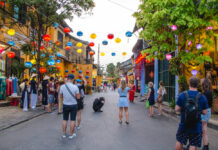Hoi An, a charming ancient town in central Vietnam, has captivated travelers with its captivating blend of history, culture, and beauty. Renowned for its well-preserved architecture, colorful lanterns, and vibrant tailor shops, Hoi An offers a unique experience that lingers long after you leave. But with so much to discover, the question arises: how many days are enough to truly immerse yourself in this enchanting destination? The ideal duration depends on your travel preferences and interests. This blog post will delve into the specifics, guiding you to determine the perfect Hoi An itinerary, ensuring you make the most of your time in this captivating town.
Is Hoi An Worth Visiting?
Hoi An is a UNESCO World Heritage Site recognized for its exceptional cultural and architectural significance. It’s a captivating destination, drawing visitors from all over the world who seek to experience a unique blend of Vietnamese history, culture, and charm. Here are some reasons why Hoi An is worth visiting:
Rich History and Culture
Hoi An’s history is a captivating tapestry woven from trade and cultural exchange. As a bustling port city during the 16th to 19th centuries, it served as a crossroads for merchants from Japan, China, and Europe. This rich past is evident in its well-preserved architecture, a mesmerizing blend of Southeast Asian and European styles. Walking through the ancient town, you’ll encounter numerous historic landmarks, offering a glimpse into Hoi An’s vibrant past.
Charming Architecture
Hoi An’s architectural heritage is truly enchanting. The ancient town boasts numerous stunning buildings, including traditional houses with colorful facades, ornate temples, and ancestral halls. The Japanese Covered Bridge, built in the 18th century, is a prominent landmark with its distinctive red roof and ornate carvings. These architectural wonders contribute to Hoi An’s unique ambiance and charm, making it a photographer’s dream destination.
Tailor-Made Experiences
Hoi An is renowned for its exceptional tailor shops. Skilled artisans can create custom-made clothing, tailoring to your exact specifications. You can select fabrics, styles, and choose from a wide range of designs, ensuring a perfect fit. This personalized experience allows you to create unique garments that will be treasured keepsakes of your Hoi An adventure.
Delicious Cuisine
Hoi An is a culinary paradise. Its traditional cuisine is a delightful mix of Vietnamese flavors with influences from China and Japan. From delectable street food stalls to cozy restaurants, you’ll find an abundance of culinary delights to savor. Some must-try dishes include Cao Lau, White Rose dumplings, and Banh Mi, a savory Vietnamese baguette.
Best time to visit Hoi An
The best time to visit Hoi An depends on your preferences and what you’re looking to experience. Keep in mind the following information when deciding when to plan your trip:
High Season
- Time: June to August
- Climate: Hot and humid, with frequent rainfall. Temperatures can reach up to 35°C (95°F).
- Crowds: Very crowded, with many tourists visiting during this peak season.
- Pros: Lots of activities and events, warm water ideal for swimming
- Cons: Higher prices, limited availability of accommodation, potential for long queues, and less comfortable weather.
Shoulder Season
- Time: April to May and September to October
- Climate: Warm and humid, with occasional rainfall. Temperatures range from 25°C to 30°C (77°F to 86°F).
- Crowds: Moderate crowds, making it a good balance of experiencing the town without huge crowds.
- Pros: Pleasant weather, lower prices, and fewer crowds compared to high season.
- Cons: Some shops and restaurants may have limited hours or be closed.
Low Season
- Time: November to March
- Climate: Mild and dry, with temperatures ranging from 20°C to 25°C (68°F to 77°F).
- Crowds: Least crowded time to visit, with lower prices and more availability.
- Pros: Most comfortable weather, lower prices, and fewer crowds.
- Cons: Some activities and events may be limited due to the off-season.
How long to spend in Hoi An?
The ideal length of your stay in Hoi An depends on your interests and travel style. If you want to relax and immerse yourself in the town’s unique atmosphere, two to three days is a good starting point. For those who want to explore the surrounding areas and delve deeper into Vietnamese culture, a week or more may be necessary.
Below are some sample itineraries that can help you plan your perfect Hoi An stay:
One Day Itinerary in Hoi An
This itinerary focuses on exploring the essence of Hoi An’s captivating charm.
Morning:
- Visit the Japanese Covered Bridge: This iconic landmark reflects Hoi An’s rich history and cultural exchange.
- Discover the Old Town: Walking through the ancient streets, you’ll encounter colorful houses, ancient temples, and charming shops.
- Explore the Tan Ky Old House: Step back in time at this well-preserved house, showcasing traditional architecture and living spaces.
Afternoon:
- Lunch at a local restaurant: Savor the flavors of Hoi An’s distinctive cuisine, sampling street food or enjoying a traditional meal.
- Tailoring Experience: Explore the tailor shops and choose fabrics and designs for a bespoke outfit created for you.
- Relax at a riverside cafe: Enjoy the peaceful ambiance along the Thu Bon River, sipping coffee or tea.
Evening:
- Explore the night market: Immerse yourself in vibrant atmosphere of the evening market, with its food stalls, lanterns, and local handicrafts.
- Admire the Lantern Festival: Experience the mesmerizing beauty of lanterns illuminating the ancient town.
Two Days Itinerary in Hoi An
This itinerary expands on the first day, adding more depth and exploration.
Day One:
- Morning: Follow the same schedule as the One Day Itinerary.
- Afternoon:
- Explore the Hoi An Museum of History and Culture: Learn about Hoi An’s fascinating past, its role in trade, and its cultural evolution.
- Visit the Assembly Hall of the Cantonese Chinese Congregation: Discover the intricate architecture and learn about the influence of Chinese culture on Hoi An.
- Evening:
- Dine at a waterfront restaurant: Enjoy a delightful dinner overlooking the Thu Bon River, where you can witness the colorful sunset.
- Take a cooking class: Learn to prepare traditional Hoi An dishes, gaining insights into local culinary traditions.
Day Two:
- Morning:
- Take a boat trip to the Tra Que Vegetable Village: Discover the traditional farming methods and enjoy a relaxing boat ride on the Thu Bon River.
- Explore the colorful street art: Discover hidden alleyways with vibrant murals, adding a modern twist to the traditional charm.
- Afternoon:
- Visit the Thu Bon River: Enjoy a peaceful stroll along the riverbank, admiring the picturesque scenery.
- Spend time at An Bang Beach: Relax on the sandy shores, bask in the sun, or indulge in water activities.
- Evening:
- Enjoy a farewell dinner: Savor a final meal, reflecting on your wonderful Hoi An experience.
Three Days Itinerary in Hoi An
This itinerary offers a more comprehensive exploration of Hoi An and its surrounding areas.
Day One and Two:
- Follow the same schedule as the Two Day Itinerary
Day Three:
- Morning:
- Embark on a day trip to My Son Sanctuary: Explore the ancient Cham ruins, dating back to the 2nd century, offering a glimpse into the rich cultural heritage of the Champa kingdom.
- Afternoon:
- Visit the Marble Mountains: Explore the five marble peaks, home to caves, pagodas, and stunning views.
- Discover the Marble Village: Immerse yourself in the vibrant artistry of this local village, renowned for its marble craftsmanship.
- Evening:
- Return to Hoi An: Enjoy a final evening in the town, perhaps indulging in a farewell dinner or strolling through the streets, reflecting on your unforgettable journey.
More day trips from Hoi An
While Hoi An itself is a treasure trove of experiences, the surrounding areas offer even more opportunities to explore the beauty of central Vietnam.
My Son Sanctuary:

- Location: Located about 40 kilometers (25 miles) southwest of Hoi An.
- Highlights: A UNESCO World Heritage Site known for its ancient Cham ruins dating back to the 2nd century. Discover the impressive temples and intricate carvings, offering a glimpse into the rich cultural heritage of the Champa kingdom.
- Best Time to Visit: During the dry season (February to August), but avoid the hottest months of June to August.
Marble Mountains:

- Location: Located about 10 kilometers (6 miles) southeast of Da Nang, about 30 kilometers (19 miles) from Hoi An.
- Highlights: Five marble peaks adorned with caves, pagodas, and stunning views. Explore the intricate carvings inside the caves, with shrines dedicated to different deities.
- Best Time to Visit: Visit during the cooler months (October to March) but be aware of crowds during peak season.
Tra Que Vegetable Village:

- Location: Located about 4 kilometers (2.5 miles) north of Hoi An.
- Highlights: Experience the traditional farming methods of this village, renowned for its organic vegetables. Take a boat trip through the rice paddies, witness the ancient techniques, and enjoy a relaxing escape from the bustling town.
- Best Time to Visit: Anytime of year, but for the best experience, visit during the harvesting season (March to August).
Cua Dai Beach:

- Location: Located about 5 kilometers (3 miles) east of Hoi An.
- Highlights: A long stretch of pristine beach, offering a peaceful escape from the town. Enjoy swimming, sunbathing, and exploring the coastline.
- Best Time to Visit: During the dry season (February to August) for the best weather and water conditions.
Hue:

- Location: Located about 120 kilometers (75 miles) north of Hoi An.
- Highlights: The former imperial capital of Vietnam, boasting stunning imperial palaces, temples, and pagodas. Explore the Citadel, the Thien Mu Pagoda, and learn about the history of the Nguyen Dynasty.
- Best Time to Visit: Avoid the rainy season (October to January) for the most pleasant weather.
Conclusion
Ultimately, the perfect number of days to spend in Hoi An depends on your individual preferences and the pace you wish to set. Whether you choose a one-day whirlwind tour or a week-long immersion in its culture and charm, Hoi An promises an unforgettable experience. With its historic architecture, vibrant atmosphere, and delicious cuisine, this captivating town will leave you with cherished memories that linger long after you leave. So pack your bags, embrace the enchanting allure of Hoi An, and create your own unique adventure in this captivating Vietnamese gem.
























